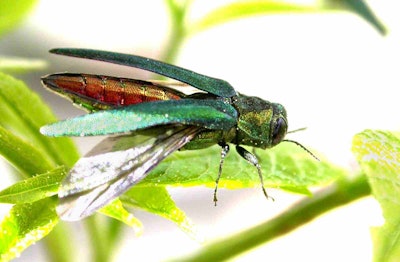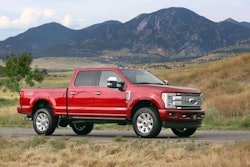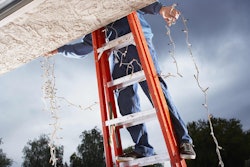 Photo: USDA/Flickr
Photo: USDA/FlickrSince its 2002 discovery in Michigan, the emerald ash borer (EAB) has continued to spread from state to state, devastating ash tree populations.
According to the United States Department of Agriculture’s (USDA) detection map, the EAB has now spread to 35 states and three Canadian provinces, as of July 2, 2018, and recently it was spotted in Rhode Island.
The Rhode Island Department of Environmental Management (DEM) says the EAB was found for the first time in the state on July 25, and Rhode Island has officially joined the federal quarantine covering much of the eastern United States in the hopes of slowing the insect’s spread.
According to the Block Island Times, the Animal and Plant Health and Inspection Service (APHIS) of the USDA confirmed the identification of a beetle found in Washington County. The insect was found, the Block Island Times reports, during annual monitoring surveys conducted by the USDA, the Rhode Island DEM and the University of Rhode Island.
Many more traps around the state are being inspected by APHIS, and the Block Island Times claims there is a high likelihood that there will be more positive EAB identifications announced later on.
Currently, the DEM is finalizing a plan aimed to slow the spread of EAB and assist Rhode Island landowners and municipalities in raising awareness of EAB and other invasive pests, reducing risks and identifying and inventorying ash trees.
The first step of the plan, according to the Block Island Times, is to join the federal quarantine. The DEM’s Division of Forest Environment is also preparing a guidance document to help communities and homeowners develop response plans.
Last year, the International Union for Conservation of Nature (IUCN) listed five prominent species of ash trees in North America as critically endangered. These fives species were the green, black, blue, white and pumpkin ash.
About EAB
EAB larvae cause the deterioration that leads to the tree’s death. The larvae chew through the bark and consume the tissues, creating S-shaped galleries that serve as the tell-tale sign of their arrival. This disrupts the flow of nutrients and water, which causes the tree to starve slowly. By the time the symptoms are noticed, it’s too late to help the tree.
Generally, the first visible signs are found in crown dieback, and if more than half of the canopy is dead, there is no treatment that can save it. Other signs of EAB that can be found along the trunk are D-shaped exit holes and water sprouts. Currently, there is no cure for the EAB infestation, but proactive steps are being taken, and insecticide applications have proven effective in protecting the ash trees.
“Ash trees are essential to plant communities of the United States and have been a popular horticultural species, planted by the millions along our streets and in gardens,” said Murphy Westwood, member of the IUCN Global Tree Specialist Group and director of global tree conservation at The Morton Arboretum. “Their decline, which is likely to affect over 80 percent of the trees, will dramatically change the composition of both wild and urban forests. Due to the great ecological and economic value of ash trees, and because removing dead ash trees is extremely costly, much research is currently underway across sectors to halt their devastating decline. This brings hope for the survival of the species.”
Prevention and treatment
Currently, there are only two methods of dealing with EAB. The threatened ash tree will either need to be removed and replaced, or a program of insecticide treatments can be started once the beetle has been detected within 15 miles of the ash tree.
To determine which option is the most effective choice, click here to see the Urban Tree Alliance’s cost calculator.
Treatment options include soil-injected systemic insecticides, trunk-injected systemic insecticides, systemic basal trunk sprays and protective cover sprays.
Treatments must be renewed every few years, depending on the chemicals used, and some of the common active ingredients in insecticides used to control EAB are imidacloprid, dinotefuran, azadirachtin and emamectin benzoate.
Emamectin benzoate can provide two years’ worth of consistent protection with a single application, while trunk injections of azadirachtin can sometimes only provide one to two years of coverage, depending on the EAB pressure.
When applied to the soil and the base of the trunk in the spring instead of fall, imidacloprid and dinotefuran have been found more effective.
Peak egg hatch and larval establishment occurs between early June and mid-August, and because the insecticides are systemic and transported within the tree, they must be applied before the larvae can disrupt the tree’s xylem and phloem tissue.
Absorbed and distributed quickly, trunk injections take about one to four weeks, while soil applications can take four to eight weeks. Basal trunk sprays won’t wound the tree and are quick to apply, however, the sprayers must be calibrated to allow the proper amount of product application.
While designed to target adult EAB on leaves, protective cover sprays are less common and have limited effectiveness, and spray drift is common and can harm other organisms.
Ash trees have a better probability of surviving this insect if the tree has maintained a healthy status by being properly pruned, not infected by other pests and watered adequately.
While treatment options may be deemed “too expensive” by some, recent economic analyses concluded that treating the trees with effective systemic insecticides is much less costly than removing them. The value, size, location and health of the tree should be taken into consideration when deciding between treatment or removal.
Since the EAB can overwinter in dead wood, individuals are encouraged to only use firewood that’s locally sourced, since transporting firewood can spread the insect to other locations. Often, there are quarantines set up forbidding the transportation of the infested ash wood.










